Expedition: Kayaking Nepal
ONLINE SLIDESHOW
For more photos and an audio interview with Sean Glaccum, The Bhote Kosi
The Bhote Kosi Team: Sean Glaccum, Joe Carberry, Andy Sommer
Location: The Khumbu Region of Northeast Nepal
Objective: Kayak the Bhote Kosi and Imja Khola
Duration: 16 days
SEAN GLACCUM HAS his eye on all eight of Nepal’s 8,000-meter peaks, but he’s not after the summits. A 25-year-old river guide from Ketchum, Idaho, Glaccum is on a quest to become the first person to kayak the major rivers that drain the highest mountains in the Himalayan kingdom. Between 1998 and 2001, he paddled three of the steep, glacial waterways: the Modi Khola, which tumbles off the slopes of 26,504-foot Annapurna, plus Dhaulagiri’s Rahughat Khola and Kangchenjunga’s Ghunsa Khola, chalking up three first descents along the way.
“I like paddling the tight, technical rivers you find at altitude,” he says. “The views are unbelievable, and you have these places all to yourself.”
In October, Glaccum knocked off two more of the rarely explored rivers, this time with Joe Carberry, 26, a writer from Boise, and Andy Sommer, 33, an expedition kayaker from Frankfurt, Germany. The team completed a first descent of the Bhote Kosi, a daunting Class V river that drops 200 to 300 feet per mile as it drains 26,906-foot Cho Oyu. (The Colorado River, by comparison, drops about eight feet per mile as it runs through the Grand Canyon.) Next they descended the Imja Khola, which drains Everest and Lhotse and was first paddled by British kayaker Mike Jones in 1976. On a tiny budget of $600 per person, including in-country airfare, Glaccum, his team, and three porters journeyed to Lukla, then spent three days hauling their Wave Sport kayaks 20 miles up the Bhote Kosi Valley to the river’s headwaters at 13,000 feet. The descent, a nine-mile run to the village of Namche Bazaar, took two days, more than half of which was spent scouting the unmapped river as it twisted its way through steep 8,000-foot canyons.
But their biggest challenge was simply keeping warm on the near-freezing alpine water. “We could only paddle when the sun was highest, between the hours of eleven and three,” Glaccum says. “Even then, we’d come into a patch of shade and there would be a 40-degree difference in temperature.” From Namche Bazaar, they trekked north on the Khumbu trail, stopping about seven miles south of Everest Base Camp at the headwaters of the Imja Khola. The trip down the seven-mile Class IV river took another two days, with breaks worked in to practice hucking off the river’s waterfalls.
Now home in Ketchum and preparing for the upcoming summer paddling season, Glaccum is heading back to Nepal next October to attempt first descents of the last two rivers on his list, those draining 26,758-foot Manaslu and 27,824-foot Makalu. “Everybody treks up mountains in Nepal,” he says. “But it’s a lot more fun going back down on the water.”


